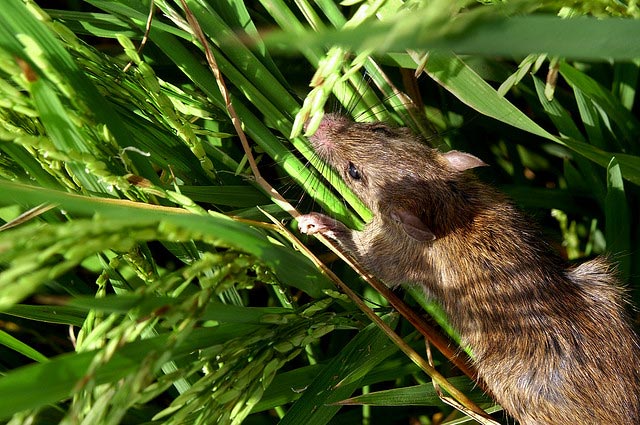Rats
 Rats do not like wide, open spaces because they are more vulnerable to attack from predators.
Rats do not like wide, open spaces because they are more vulnerable to attack from predators.
They like to hide and burrow in weedy areas near major irrigation canals, in village gardens, and in other non-crop areas which provide good cover.
Before planting is the best time to organize community rat control campaigns. These can be done until three weeks after planting.
Effective community control
- Flooding, digging, or fumagating rat burrows
- Scare rats out of areas with high vegetation cover or around villages (using netting, dogs, clubs, and others to catch rats)
- Use dogs to locate active rat burrows, then do Step 1
- Hunt rats at night using flashlights, clubs, bow and arrows, and netting
- Set local kill-traps along runways of rats
- Use registered rat poisons that are placed in covered bait stations (but not where children, pets, or livestock have easy access).
Note: Effective community campaigns will need little, if any, poisons.
Timing of community rat control
 Early action is most effective, when rats are not breeding. Community rat campaigns are best done within the first 3 weeks after planting.
Early action is most effective, when rats are not breeding. Community rat campaigns are best done within the first 3 weeks after planting.
Rats can breed very quickly. In Indonesia, Malaysia and Vietnam, in lowland irrigated rice, the rice field rat breeding cycle coincides with an abundance of food during the active tillering stage of rice. If there is one crop per year the rats breed once; if there are two crops per year, the rats breed twice. Usually, rats will produce two or three litters of 5−10 pups per cropping season, none of which will breed in that season.
The removal of one female rat before she breeds is equivalent to killing 35 rats when the crop is at the ripening phase.
Planting crops more than two weeks apart is a recipe for disaster. If neighboring crops are planted more than two weeks apart, the breeding season will be extended long enough for the first litter to have time to breed, resulting in an explosion of population numbers.
For example, consider a three-week extension to the harvesting period because crops are not planted at the same time. A single female breeding early in the season can give rise to as many as 120 rats feeding on the last crops to ripen.
Traditionally, rodents are only controlled when their numbers are high. This is the worst time to deal with the problem.
Note that the major pest species of rat in the Philippines, Laos and parts of Cambodia is different and they are able to breed during most of the year. However, their peak of breeding coincides with the maturing rice crop. So again, early action is the most effective.
In South Asia, the situation is more complicated because of different species of rodent pests. However, the principle of matching control action to the breeding ecology of the rat still applies.










